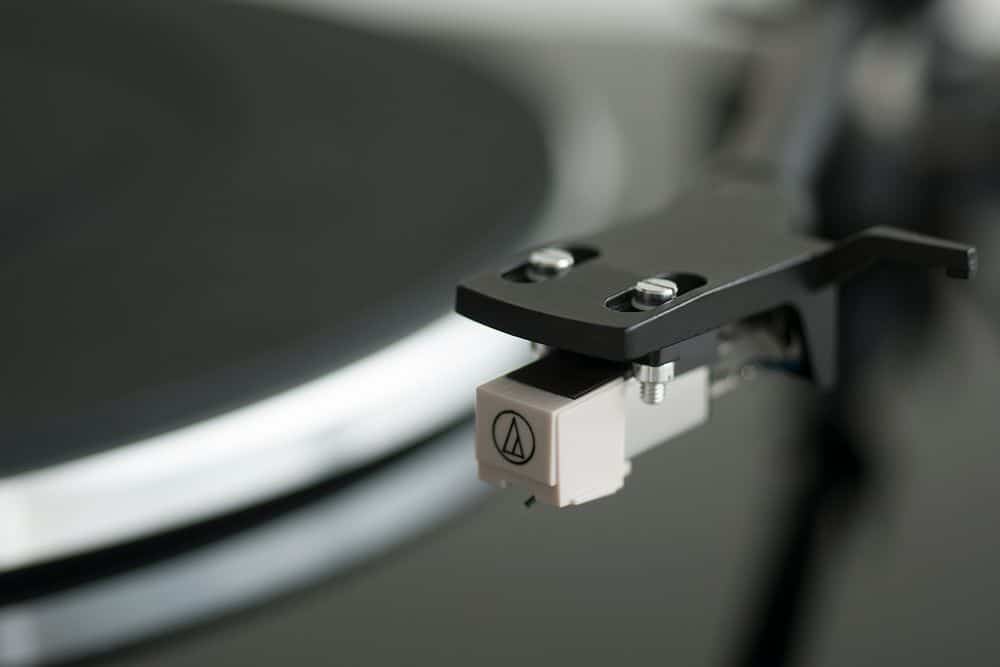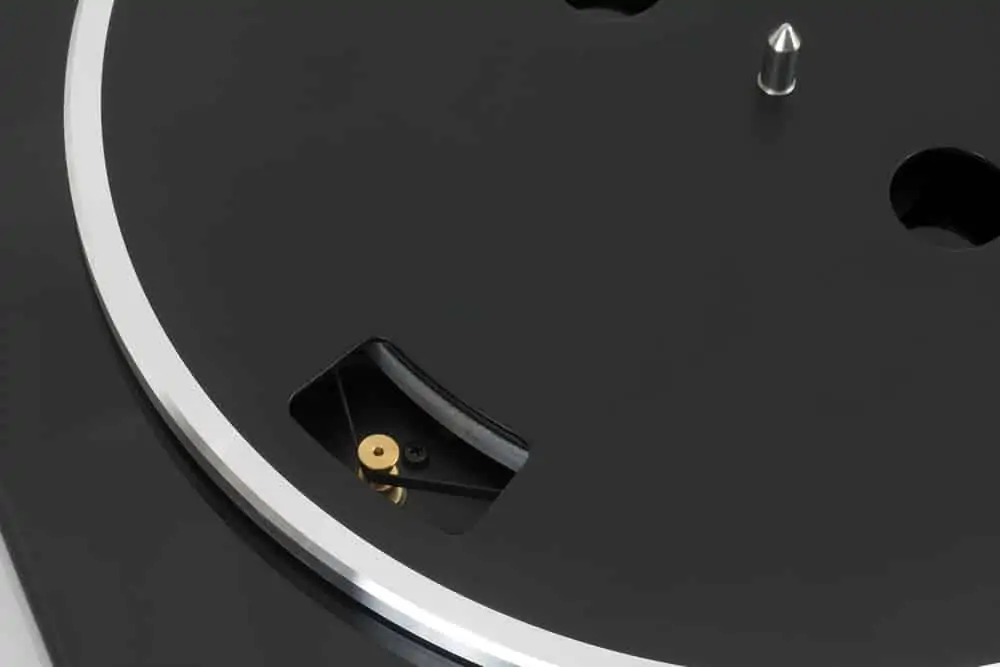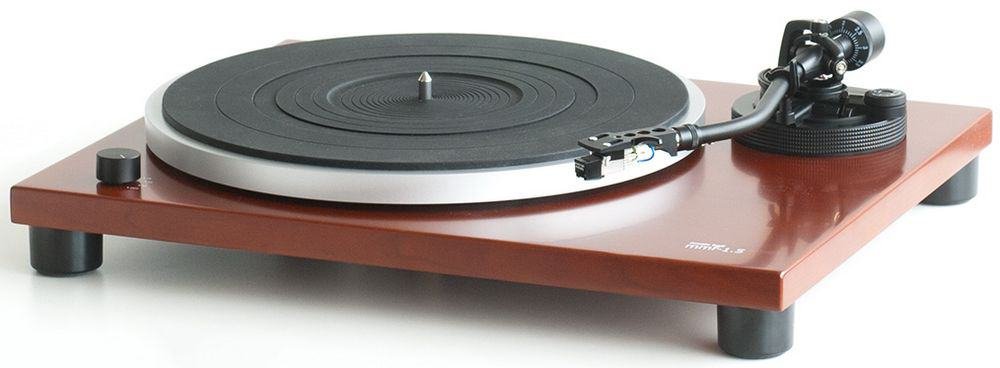Music Hall is a lesser known name in the quality record player space.
But it does not make lesser players.
Even the entry-level Music Hall MMF 1.3 is a high quality unit that punches far above its price point.
- Excellent quality parts: this thing has good circuitry inside and quality parts all around
- Great sound for the price: sounds great for the price you pay; it is quiet and reproduces the sound of your records very well
- Audiophile style unit: you could argue this is not a 'real' audiophile unit, but it is dang close and for the price, it is a steal
- AT-3600L cartridge: this is a $50 cartridge on its own; most competitors come with terrible cartridges you cannot even listen to or allow to ride on your records
- Belt drive turntable: quiet belt drive operation keeps it simple and lighter
- Built-in switchable preamplifier: this is on almost every modern turntable, but I am glad to see it here
- No pitch controls: not sure why they left this off
- No USB output: this makes no sense
But it is missing a few features that should have been included.
Despite that, you get great value.
That said, I’d pay a little more and get their next-tier model.
Keep reading this Music Hall turntable review to learn everything you need to know about the MMF-1.3.
We’ll also help you figure out whether it is the right model for you, or if the next one up would be better.
Contents
Music Hall MMF-1.3 Review: Overview And Features
The Music Hall MMF-1.3 is Music Hall’s entry-level audiophile turntable unit.
It is not nearly as popular as some of the other more well-known, classic brands in the entry audiophile turntable space, but it can hold its own against a U-Turn or a Fluance.
Like almost all ‘audiophile’ turntables, the Music Hall MMF-1.3 is a belt-driven record player.
It looks an awful lot like a U-turn except in the case of the Music Hall, the belt is not on top of the chassis (thank goodness: I think that is just silly).

The theory of using belt drives on audiophile turntables is that belt drives are quieter than direct drives because the motor on direct drives sits directly below the platter and the needle.
However, I no longer subscribe to this widely held belief since I have a direct drive that is dead silent.
This unit has a built-in pre-amp you can turn off or on, which is standard these days. It also has 3 speeds: 33, 45, and even 78 RPM.
I was surprised to see the 78 speed. This is uncommon, but nice to see, especially if you have a ton of old shellac swing or big band records lying around. It comes equipped with the Audio Technica 3600L cartridge. Nice!
Key Features
- Belt-drive, electronic speed controlled motor
- Plays 33 1/3, 45, and 78 RPM
- Audio Technica AT3600L cartridge
- Beautiful, sleek, modern design
- Aluminum plinth and platter
- Built-in switchable phono pre-amp
- Vibration damping feet
Stock AT-3600L Cartridge

This was a smart move by Music Hall. The thing about buying turntables is that when you buy one, you almost always immediately need to switch out the stock cart because they usually come with garbage cartridges.
Not in this case. The cartridge that comes on this unit is an excellent quality cartridge you can leave on and play until it needs to be swapped out.
The cartridge would cost you over 50 bucks If you were to buy it new. I am not saying it is as good as an Ortofon red or something, but it is good enough to use until it dulls.
Piano Black Aluminum Plinth (Chassis)
The plinth is what gives this unit its sleek, sexy look. It is an aluminum plinth that helps keep the weight down. Wood or steel would have easily doubled the weight from 11 pounds to nearly 20.
The aluminum is finished with a glossy black piano finish. While I am a huge fan of the piano finish, it is a magnet for scratches and fingerprints. I prefer matte or wood personally.
The plinth has 4 soft vibration dampening feet on the bottom. The idea here is that the vibration dampening feet keep the plinth from absorbing the vibrations around it, keeping the sound purer.
Aluminum Platter
The platter is also aluminum, like the plinth. This is another good idea to keep the weight down, but it is nothing special.
Most record players in this range also have aluminum platters. It is the standard nowadays. The edge of the platter is polished to a shiny chrome look, which adds additional shine to an already shiny unit.
Belt Drive Motor

The belt drive motor is going to attract lots of people to this model. Many record collectors believe belt drive motors are the only way to listen to records without excess noise.
This record player has a simple belt drive motor which, in theory, keeps the motor noise out of the audio.
Sadly, this unit does not have a pitch adjustment or raised bumps on the edge of the platter for adjusting speed accuracy. Read about the importance of speed adjustment and how to adjust pitch on a turntable, even if it has no actual speed controls.
3 Speeds Of Operation
This thing plays 78 records, which is not something you are likely to see in entry-level record players. There are just not that many people still playing that old 78s.
Of course, it has 33 and 45 too, but that 78 is the only thing notable about the speeds it offers. The speeds are accessible with a turn knob that sits on top of the unit. I prefer buttons but the knob is just fine.
Music Hall MMF-1.3 Vs Music Hall MMF-1.5

These 2 units may look similar, but if you look closer, there are many differences.
Similarities
- Obviously they are both made by the same company; this is good because you know they both use quality parts, which is a huge issue sometimes with mass-produced turntables
- Without listing all the similarities one by one, I will just say that they have nearly all the same features as far as playback goes: they both have 3 speeds, manual tonearm movement up and down (see our manual vs automatic turntable article for an explanation), no auto-stop
- They both have belt drive motion, which will be seen as plus by most customers; what is going to be more informative and interesting is what is different about these 2 units
Differences
- The MMF-1.5 has the ‘S’ shaped tonearm, which is more desirable than the straight tonearm on the 1.3 version.
- The 1.5 has pitch control adjustment (though it’s not obvious); to adjust the pitch on this one you have to press and hold the speed selector knob until it blinks, then you turn it to adjust the speed
- The MMF1.5 is a full pound heavier than the MMF-1.3 due to better components
- The MMF-1.5 comes with a conical stylus (better), while the MMF-1.3 has a standard elliptical stylus (good but not as good as conical)
- Not surprisingly, there is an audible difference between the two decks; the MMF-1.5 sounds better, with warmer tones and less brittle highs than the 1.3; don’t get me wrong, the MMF-1.3 is fantastic at this price, but for about a hundred bucks more you go up a huge step
There are also higher end units from Music Hall, like the Music Hall Classic turntable. Naturally, as the price goes up, the quality increases. Basically, they have a model for every budget.
Music Hall Turntable Review: Conclusion And Rating
For the money, the Music Hall MMF-1.3 is a great entry-level audiophile style turntable.
It comes with a high-quality cart that saves you money, and it has the belt-driven, quiet operation people are asking for.
I would have expected pitch control and a USB output for this price point, but they were left off this unit. To be fair, the USB output is not even present for 100 bucks more in this line (the MMF-1.5).
Although Music Hall does not have the name recognition of Fluance or U-Turn at this point, they are making high-quality products and soon they will be just as popular as their competitors.
Because the MMF-1.5 is much better for only $100 more, the MMF-1.3 gets a rating of 4.5 out of 5.

Did you actually use this turntable before writing your review? Or any turntable? This unit uses a gloss black MDF plinth very similar to the one on the Denon DP-400 (arguably the Denon is a more refined version of this table as both are manufactured by Hanpin). The plinth is actually a good weight, however the aluminum platter is not. Not sure where you got the idea a lighter platter is a good feature, as it is just the opposite. A heavier platter ensures better moving momentum and contributes to better speed consistency as well as better sound isolation. While I am not the biggest fan of running the belt on the outside of the platter, there are reasons for doing so, so rarely is it actually “silly”. The aspect that bugged me more than anything is you stating this unti does not have pitch control when in fact it does (which was one of the selling points of this unit), there is just no strobe. There is a speed control box on the front left of the underside of the plinth. While not the easiest to get to (added specifically by Music Hall to a plinth not design to have one i.e. Denon DP-400) it is quite effective.
People rely on your reviews to be accurate, so you guys really need to do much better to be taken seriously.